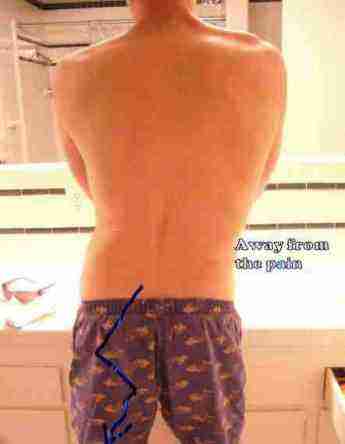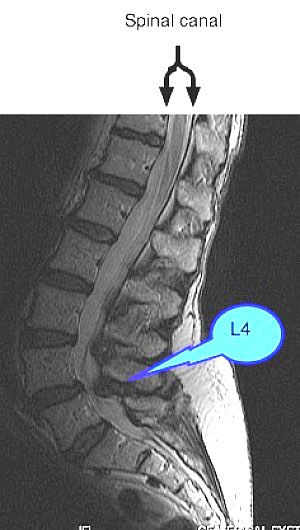Spinal Stenosis Exercise
Spinal stenosis exercise helps you keep those joints gliding smoothly over each other.
I wanted to name this page rehabilitation, but it seems that word has more to do with drugs and alcohol than preventing this most nasty condition. Narrowing of the vertebral canal afflicts mostly the older person; sixty plus. It occurs after serious injury causing conditions like spondylolysthesis, a not uncommon diagnosis caused by a fracture in the lower back in childhood when the spine is still made of cartilage; but also after repeated slipped disk or lumbar facet syndrome episodes.
Degenerative changes of the joints begin to threaten the cord, vascular elements and nerve roots from either the anterior, or posterior, or both. It is a fiercesome condition, causing buttock pain, tingling in legs and feet, and if it occurs in the neck then paresthesias in arms and hands. The cost of treatment is exhorbitant, and the pain and suffering unbelievable.
Prevention and rehabilitation of spinal injuries is the key. Don't let spinal stenosis happen to you, if you can possibly help it.
It can be a congenital condition too.
Joint cartilage has no true blood supply of its own; it is dependent on the synovial fluid that sloshes about in the joint, supplying the tissues with oxygen and nutrients, and removing waste metabolites. Should a part becomes fixated, either by subluxations, or by a plaster caste, for example, immobilisation arthritis sets in; in the spine ultimately this progresses to stenosis as the degenerative changes expand and invade the soft tissues.
This page was last updated by Dr Barrie Lewis on 27th June, 2019.
Basic lumbar spine exercises
Do these three basic lumbar spine exercises done on your bed before arising; the are simple, unlikely to aggravate the condition and take less than one minute; repeat them several times a day.
The sliding movement of the facets helps prevent that immobilisation arthritis.
To find links to topics in bold like that above use the site search function in the navigation bar on your left.
TWO MIDDLE-AGED MEN
In the last month I have had two middle-aged men in their forties with severe lower back pain. Both have had repeated episodes over the last years. Both responded well to Chiropractic care and were relatively pain free within a couple weeks.
One took my advice seriously. He has come into our rehab program using spinal stenosis exercises. The other said it was too expensive; a mere 3 to 5 consultations and an occasional but regular treatment and, since he had no pain, so why should he bother?
Sadly, within a few months the latter will probably be back, in severe pain again with the real possibility of tingling in legs and feet. Interestingly, we find that patients with chronic conditions actually have less treatment if they come into our rehab programme. It actually saves them money, not to mention pain and suffering and the real threat of lumbar spinal stenosis when they become old and grey. You can lead a horse to water, but you can't make it drink.
Each event of severe lower back pain increases the
likelihood of spinal stenosis. Prevention is the key word.
Do you regularly look like the leaning tower of Pisa? You can be sure that the likelihood of drama in
the future is relatively great if you don't start some daily exercises for your spine. It's a fact that care of the lower back
has the highest cost tag because of scans, hospitalisation and surgery; but you think that only happens to other people, perhaps. I wish you were right.
Repeated episodes of lower back pain inevitably increase the likelihood of numbness and pain and tingling in legs and feet.
My lumbar spinal stenosis exercise program takes only one and half
minutes every morning. I do it myself; daily, I rarely miss. Never,
actually, as I too have back problems; most chiropractors do.
Done on your bed first thing in the morning, simple exercises like these will make an enormous difference to your back. I particularly like this modified pelvic tilt because it not only improves your muscle tone, but the gliding action of the facets reduces the tendency to immobilisation arthritis, the inevitable result if spinal fixations are not properly managed.
In Chiropractic, we encourage you to become actively involved in the care of your back. In this instance that means spinal stenosis exercise.
Here is one more favourite core exercise. Added to the syndrome is what is known as arthrogenic inhibition of the nerve supply to the muscles around a joint; we become weak and prone to further injury.
The key is more exercises; gently whilst healing is occurring and then more vigorously after six weeks. Choose your own medicine but for my part I prefer walking, cycling and swimming, and even gardening over the gym.
SIMPLE CORE EXERCISES
These simple core exercises are for after the severe pain has abated. They too don't take long; you can surely make two minutes every morning to prevent a re-occurrence of the pain.
Ant-algia
Ever find yourself standing, and looking for all the world like a question mark? It's a very serious sign called an antalgia.
Notice how this young man is leaning AWAY from the pain. It's the classic sign of a postero lateral disk herniation ...
Not carefully managed, including an disciplined lower back exercises programme it leads inevitably to spinal stenosis in later life. Chronic lower back and leg pain ....

- Antalgic posture ...
SPINAL STENOSIS EXERCISE
Prevention is the word. Take it seriously; really, it can happen to you. YOU! The first step is to have your low back pain carefully and properly assessed and treated.
Of course, I have a vested interest and would like to see you consult a chiropractor, but at least see someone you trust who can manage your lower back pain; then start this spinal stenosis exercise.

Lumbar Spinal Stenosis
This elderly lady could barely walk, so severe was the pain in her back, and the ache and tingling in her legs and feet, when she first came for chiropractic care. Yes, she has osteoporosis, and Medicine says that no woman of that age, in her right mind, would consider manipulation. It's far too dangerous; they might break your bones.
Ribs, yes, nine at the last count in thirty five years, I confess. Can manipulation fracture vertebrae? Absolutely not, and it's the initial treatment of choice for lumbar spinal stenosis, done gently and skillfully; it won't always have a satisfactory outcome, however.
Cervical spine stenosis can be more difficult.
Notice how the spinal cord is under pressure at the L4 level, low in the back. Chronic repeated lumbar facet syndrome injuries have caused serious degenerative changes posteriorally, threatening the cauda equina.
Extension of her lower back caused severe pain down her leg. She now comes once a month for chiropractic care, to maintain the progress in her condition, but everything hangs on these spinal stenosis exercises which she does faithfully. One and half minutes is all they take. She can now walk for half an hour before the pain begins.
This dear lady confided that, since she hadn't
been able to walk, she felt her mental state was slipping. She was
becoming increasingly forgetful and there were definite signs of mild
cognitive impairment. This is no coincidence; there is a strong inverse
correlation between
Alzheimers and exercise. The less you walk, the greater the likelihood of losing your marbles.
Consensus statement
Reported in the prestigious journal, Spine, in 2013 the North American Spinal Society made an interesting 'consensus statement'. I quote a few excerpts.
- LSS is a difficult clinical entity, both considering diagnosis and treatment.
- LSS is defined when there is diminished room for nerve and blood vessels after degenerative changes in the spinal canal.
- It may be quite unsymptomatic.
- When symptomatic variable patterns of buttock and leg pain are common, with or without lower back pain.
- Walking and extension commonly increases the pain.
- Leaning forwards, sitting and lying down commonly relieve the pain.
Natural history of LSS
- In nearly a half of patients the condition will spontaneously improve without treatment.
- Sudden, severe neurological decline is most uncommon.
Treatment of LSS
There is currently no research proving that any treatment of LSS is better than the favourable improvement that occurs spontaneously in nearly one half of patients; don't be pressured into early surgery.
Of the researched treatments, epidural steroid injections guided by contrast enhanced fluoroscopy was found to be best.
In the absence of the fluoroscopy to accurately guide the delivery of the steroid to the correct site, short term relief only was obtained.
A corset helped both with pain and increased the distance patients could walk.
Decompressive surgery was recommended only in those with moderate to severe LSS, and only after time has passed; the body has wonderful healing properties of its own.
There is currently insufficient evidence, for or against, to state whether medication, physical therapy, spinal stenosis exercise, spinal manipulation, traction or electrical stimulation might help.
In short
In short both medicine and chiropractors find LSS a difficult clinical entity; various treatments may help but the research confirming it is scanty.
There is only anecdotal evidence, such as the case file above that chiropractic may help.
The condition may spontaneously resolve in nearly a half of patients, given some common sense and avoiding obviously difficult movements.
Prevention is the key; spinal stenosis exercises.
Straight leg raise
What's perhaps odd is that the test for sciatica, the so called straight leg raise is often negative, or only weakly positive. The nerve may not be pinched in the normal sense but affected by a strongly inflammatory exudate from the degenerating joints.
Tingling in feet and legs
Tingling in feet and legs has many causes but the most common is an abnormality in the lower back; usually it's very treatable with chiropractic help but it does involve various facets; these spinal stenosis exercises, started early in the history, will help.
- Accepting that you have to exercise your back every day.
- Not lifting absurdly heavy and awkward things for a period, and perhaps for ever.
- Being compliant with your chiropractor's instructions. In a difficult case that might involve a treatment every month or two for a period, and sometimes for ever.
Chiropractic
Chiropractic is not magic; it's hard work in which your doctor attempts to normalise your spine. Some things cannot be undone but in most cases if the bones are set correctly in movement again, nature takes over, reestablishing the normal nutritional flow of nutrients to the spine; you have the responsibility to do these spinal stenosis exercises.
Work with your chiropractor; you'll be pleasantly surprised at the progress usually made. A cure? Certainly not, but relief and progress, same as diabetic gets from his doctor's care. There's no cure there either.
The diabetic who fights with his doctor, and the non compliant spinal stenosis patient have only themselves to blame when matters turn south.
USEFUL LINKS
Did you find this page useful? Then perhaps forward it to a suffering friend. Better still, Tweet or Face Book it.
